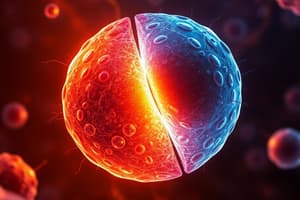Podcast
Questions and Answers
Quais são as principais diferenças entre a mitose e a meiose em termos de número de células-filhas?
Quais são as principais diferenças entre a mitose e a meiose em termos de número de células-filhas?
- A meiose produz 2 células-filhas, enquanto a mitose produz 4 células-filhas.
- A mitose produz 2 células-filhas, enquanto a meiose produz 4 células-filhas. (correct)
- A meiose produz células-filhas com o dobro do número de cromossomos que a célula-mãe, enquanto a mitose produz células-filhas com o mesmo número de cromossomos.
- A mitose produz células-filhas com o mesmo número de cromossomos que a célula-mãe, enquanto a meiose produz células-filhas com o dobro do número de cromossomos.
Qual é o resultado da meiose em termos de número de cromossomos nas células-filhas?
Qual é o resultado da meiose em termos de número de cromossomos nas células-filhas?
- As células-filhas têm um número aleatório de cromossomos.
- As células-filhas têm o mesmo número de cromossomos que a célula-mãe.
- As células-filhas têm metade do número de cromossomos que a célula-mãe. (correct)
- As células-filhas têm o dobro do número de cromossomos que a célula-mãe.
Qual é a principal contribuição da meiose para a variação genética?
Qual é a principal contribuição da meiose para a variação genética?
- A meiose introduz variação genética através da mutação genética.
- A meiose introduz variação genética através da segregação independente e do crossing over. (correct)
- A meiose introduz variação genética através da duplicação de cromossomos.
- A meiose não introduz variação genética.
Quais são as principais diferenças entre a prophase I e a prophase II?
Quais são as principais diferenças entre a prophase I e a prophase II?
Qual é o resultado final da meiose em termos de número de células?
Qual é o resultado final da meiose em termos de número de células?
Qual é o propósito da mitose?
Qual é o propósito da mitose?
Quantas células-filhas são produzidas no final da mitose?
Quantas células-filhas são produzidas no final da mitose?
Qual é a principal diferença entre a mitose e a meiose?
Qual é a principal diferença entre a mitose e a meiose?
Qual é a fase da mitose em que os cromossomos se alinham no centro da célula?
Qual é a fase da mitose em que os cromossomos se alinham no centro da célula?
Qual é o propósito biológico da meiose?
Qual é o propósito biológico da meiose?
Flashcards are hidden until you start studying
Study Notes
Cell Division
Mitosis
- Definition: Process of cell division that results in two daughter cells with the same number of chromosomes as the parent cell.
- Purpose: Allows for growth, repair, and replacement of cells in multicellular organisms.
- Stages:
- Interphase: Cell grows, replicates DNA, and prepares for cell division.
- Prophase: Chromatin condenses, nuclear envelope breaks down, and centrioles move to opposite poles.
- Metaphase: Chromosomes line up at the center of the cell, attached to the spindle fibers.
- Anaphase: Sister chromatids separate and move to opposite poles.
- Telophase: Nuclear envelope reforms, and chromatin uncondenses.
- Cytokinesis: Cytoplasm divides, and the cell splits into two daughter cells.
Meiosis
- Definition: Process of cell division that results in four non-identical daughter cells with half the number of chromosomes as the parent cell.
- Purpose: Allows for genetic variation and the production of gametes (sperm and egg cells) in sexually reproducing organisms.
- Stages:
- Interphase: Cell grows, replicates DNA, and prepares for cell division.
- Prophase I: Chromatin condenses, nuclear envelope breaks down, and homologous chromosomes pair up.
- Metaphase I: Paired chromosomes line up at the center of the cell, attached to the spindle fibers.
- Anaphase I: Homologous chromosomes separate and move to opposite poles.
- Telophase I: Nuclear envelope reforms, and chromatin uncondenses.
- Prophase II: Chromosomes condense, nuclear envelope breaks down, and centrioles move to opposite poles.
- Metaphase II: Chromosomes line up at the center of the cell, attached to the spindle fibers.
- Anaphase II: Sister chromatids separate and move to opposite poles.
- Telophase II: Nuclear envelope reforms, and chromatin uncondenses.
- Cytokinesis: Cytoplasm divides, and the cell splits into four daughter cells.
Key Differences between Mitosis and Meiosis
- Number of daughter cells: Mitosis produces 2 daughter cells, while meiosis produces 4 daughter cells.
- Number of chromosomes: Mitosis results in daughter cells with the same number of chromosomes as the parent cell, while meiosis results in daughter cells with half the number of chromosomes.
- Genetic variation: Meiosis introduces genetic variation through crossing over and independent assortment, while mitosis does not.
Studying That Suits You
Use AI to generate personalized quizzes and flashcards to suit your learning preferences.




